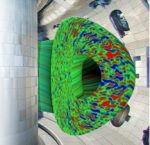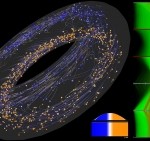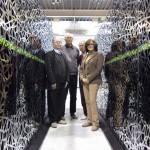July 6, 2022 — Today, the U.S. Department of Energy (DOE) announced awards for 18 projects with private industry to enhance collaboration with DOE national laboratories and U.S. universities to take on challenges in fusion energy development. The 18 selected projects include representation from 10 private companies. The full list of planned awards can be […]
Summit and Theta Supercomputers Power ML Models for Fusion Energy Research
A team led by C.S. Chang at Princeton Plasma Physics Laboratory (PPPL) has used the Oak Ridge Leadership Computing Facility’s (OLCF’s) 200-petaflop Summit and Argonne Leadership Computing Facility’s (ALCF’s) 11.7-petaflop Theta supercomputers, together with a supervised machine learning program called Eureqa, to find….
Traverse Supercomputer to accelerate fusion research at Princeton
Princeton’s High-Performance Computing Research Center recently hosted a ribbon-cutting ceremony for Traverse, it’s newest supercomputer. Traverse is a 1.4 petaflop HPC cluster that ranks among the top 500 systems in the world. “Traverse is a mini version of ORNL’s Summit, thereby providing a stepping stone for the research community to one of the world’s fastest supercomputers,” said Curt Hillegas, associate CIO, Research Computin. “Getting experience using Traverse will allow our research groups to adapt their codes, so they can use the current leadership-class machines and be best prepared for the new exascale systems.”
ORNL to lead INFUSE Network for Fusion Energy Program
The Department of Energy has established the Innovation Network for Fusion Energy program, or INFUSE, to encourage private-public research partnerships for overcoming challenges in fusion energy development. “Researchers and scientists in the Department of Energy are developing new tools to predict the performance, reliability and economics of fusion reactor concepts.”
Advancing Fusion Science with CGYRO using GPU-based Leadership Systems
Jeff Candy and Igor Sfiligoi from General Atomics gave this talk at the GPU Technology Conference. “Gyrokinetic simulations are one of the most useful tools for understanding fusion science. We’ll explain how we designed and implemented CGYRO to make good use of the tens of thousands of GPUs on such systems, which provide simulations that bring us closer to fusion as an abundant clean energy source. We’ll also share benchmarking results of both CPU- and GPU-Based systems.”
Mira Supercomputer Shaping Fusion Plasma Research
The IBM Blue Gene/Q supercomputer Mira, housed at the Argonne national laboratory Argonne Leadership Computing Facility (ACLF), is delivering new insights into the physics behind nuclear fusion, helping researchers to develop a new understanding of the electron behavior in edge plasma – a critical step to creating an efficient fusion reaction.
Mira Supercomputer Powers Plasma Turbulence Simulations for Fusion Energy
Researchers from Princeton Plasma Physics Laboratory are using supercomputing power from Argonne to tackle the daunting challenge of fusion energy.
Intel Xeon Phi Boosts Helios Supercomputer to 2 Petaflops for ITER Fusion Project
The French CEA is expanding the power of the Helios supercomputer in Japan with additional Intel Xeon Phi coprocessors.










